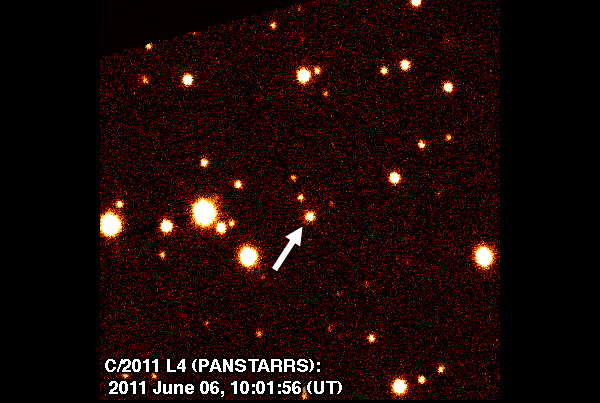Newfound Comet Will Swing By Earth in 2013

A newfound comet discovered by a telescope designed to hunt for dangerous asteroids will make its closest pass by Earth in 2013 and should be visible to the naked eye when it draws near, astronomers say.
Hawaii's Pan-STARRS 1 telescope detected the comet, which is called C/2011 L4 (PANSTARRS), on the night of June 5 and 6, and the discovery was confirmed by follow-up observations with a different instrument a day later. The comet will likely come within about 30 million miles (50 million kilometers) of the sun in February or March 2013 — about the same distance as the planet Mercury, researchers said.
During its closest approach to Earth in two years, comet C/2011 L4 (PANSTARRS) likely to be visible low in the western sky shortly after sunset, weather permitting. Skywatchers interested in seeing the newfound icy wanderer should look up then, because they may never get another chance to see it. [Photo of comet C/2011 L4 (PANSTARRS)]
"The comet has an orbit that is close to parabolic, meaning that this may be the first time it will ever come close to the sun, and that it may never return," said the University of Hawaii's Richard Wainscoat in a statement. Wainscoat helped confirm the comet's existence.
Right now, C/2011 L4 (PANSTARRS) is about 700 million miles (1.2 billion km) from the sun, placing it beyond the orbit of Jupiter. It is currently so faint that only telescopes with sensitive electronic detectors can pick it up.
The comet's clunky moniker is slightly unusual. Comets are usually named after their discoverers, but in this case such a large team of researchers helped spot the icy wanderer that it took the name of the telescope instead.
Pan-STARRS 1 found the comet while scanning the sky for potentially hazardous asteroids — ones that may someday hit Earth. The comet, however, poses no danger to our planet, researchers said.
Breaking space news, the latest updates on rocket launches, skywatching events and more!
The telescope has a 1.8-meter-diameter mirror and the largest digital camera in the world at 1.4 billion pixels. Pan-STARRS 1 takes an image every 45 seconds, and each of these pictures is nearly 3 gigabytes in size.
Comet C/2011 L4 (PANSTARRS) most likely originated in the Oort cloud, a halo of icy objects in the far reaches of the solar system. The comet was probably flung toward the sun by a distant passing star, researchers said.
Over the next few months, astronomers will continue to study the comet, which will allow better predictions of how bright it will eventually get, researchers said.
Follow SPACE.com for the latest in space science and exploration news on Twitter @Spacedotcom and on Facebook.

Space.com is the premier source of space exploration, innovation and astronomy news, chronicling (and celebrating) humanity's ongoing expansion across the final frontier. Originally founded in 1999, Space.com is, and always has been, the passion of writers and editors who are space fans and also trained journalists. Our current news team consists of Editor-in-Chief Tariq Malik; Editor Hanneke Weitering, Senior Space Writer Mike Wall; Senior Writer Meghan Bartels; Senior Writer Chelsea Gohd, Senior Writer Tereza Pultarova and Staff Writer Alexander Cox, focusing on e-commerce. Senior Producer Steve Spaleta oversees our space videos, with Diana Whitcroft as our Social Media Editor.

